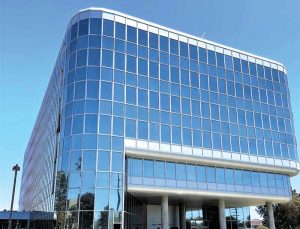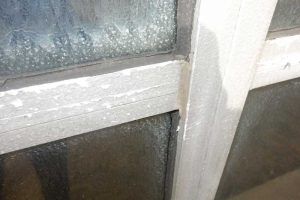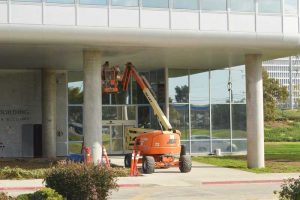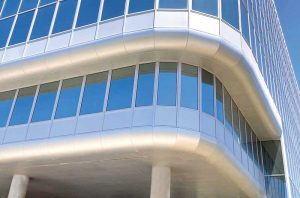
by Christopher C. Incorvaia
A striking, early example of late modern “high-technology” architecture received a 21st century facelift. Its aluminum-clad exterior was refinished with a polyvinylidene fluoride (PVDF) based coating system, restoring the building’s façade to a just-like-new condition designed to last for over 20 years.
Preserving modern history
When it was completed in 1972, the Hawthorne Federal Building in Hawthorne, California, served as the West Coast headquarters for the Federal Aviation Administration (FAA). The six-story rectangular building with rounded corners was the first in Southern California to be designed with a mirrored glass “skin,” an element which would become ubiquitous on corporate architecture in the 1970s and 1980s.
The “skin” included flat surfaces of extruded anodized aluminum paneling and glass which were wrapped around the building’s concrete structural system. Thin, shallow, reverse mullion profiles made the curtain wall appear as one continuous surface.

In 2015, the Hawthorne Federal Building was officially listed in the National Register of Historic Places, and soon thereafter, the federal government’s General Services Administration (GSA) decided to sell it. Before the sale was completed, the Los Angeles Conservatory got involved, working closely with the GSA to ensure the building would receive long-term protection through a conservation easement placed as a condition of sale. The easement required any proposed changes to the exterior of the building and landscape to conform to nationally recognized preservation standards.2
“Often it is a younger generation that sees value in these later, newer buildings that are just emerging as historic landmarks of the future,” said the Conservancy. “Now that the 1970s-era built environment is crossing the 50-year threshold, enough time has passed to start understanding, recognizing, and protecting these places, too.”
Worthe Real Estate Group of Santa Monica, California, purchased the property in 2019, and began an extensive interior and exterior rehabilitation. The Conservancy was “very excited to see this building rehabilitated and put back into its original use, demonstrating again how old can indeed become new again.”
Uncovering significant substrate damage

The author’s company took on the assignment of refinishing the building’s 3716-m2 (40,000-sf) Class 1 clear anodized aluminum exterior, from the ground floor to the roof—including all window surrounds, window frames, façade panels, soffit panels, and turns. The first order of business was to conduct a full NACE inspection of the façade to better understand its condition and determine the best path for restoration.
The team discovered the building’s façade had been painted several times in the past with a matte, silver-gray aluminum-colored paint—most recently in 1990 and 2009—resulting in a buildup of 0.20 to 0.33 mm (8 to 13 mils) of previously applied paint. The multiple paint layers had degraded and lost their adhesion, leading to widespread delamination and flaking. The damage was so severe, portions of the underlying aluminum substrate were exposed to the elements and subsequently became corroded and pitted.
The damage was clearly visible at a casual glance. The team would need to remove all the previous paint, so their technicians could properly prepare the surface to ensure good adhesion of the coating system. The building’s historical status meant less aggressive removal processes needed to be applied. To meet these requirements, the team proceeded with multi-stage mockups showing the results of various removal methods, to determine the most efficient approach. They also removed metal-to-metal and metal-to-glass sealants from around panels and window frames.

Once they determined the proper corrosion mitigation method, the team continued the mockup process by applying an AAMA 2605-approved primer system at a minimum dry film thickness (DFT) reading of 0.03 mm (1.5 mils). This was followed by an AAMA 2605-approved fluoropolymer topcoat at a minimum DFT reading of 0.05 mm (2 mils), for an overall minimum DFT of 0.08 mm (3.5 mils).
The primer and topcoat contain a water-based PVDF resin ideal for air-dry, field-applied coatings. The premium, weather-resistant coating is designed to be easily applied to a variety of substrates, including metals, plastics, wood, concrete, stucco, EIFS, and previously painted surfaces. Additional weathering data on the coating indicates an expected 20- to 30-year lifecycle, well past the manufacturer’s formal 15-year guarantee. Its resin and complex inorganic pigments give it the ability to resist film erosion, chalking, and fading caused by harsh ultraviolet (UV) exposure.
The coating’s manufacturer offers special training to certified applicators, to teach them about the chemistry behind the product. Applicators also learn details around pre-job testing, color matching, application mockups, on-the-job troubleshooting, and post-installation quality assurance, to give them confidence the coating will perform for the projected 20-plus years.
Throughout the entire mockup process, the author’s company worked closely with the manufacturer’s coatings experts to capture photos and create detailed condition reports at every stage.
Matching the original design intent
To maintain the appearance and design intent of the building’s original clear anodized aluminum finish, the author’s company worked closely with the coating supplier’s chemists, who engineered a custom-colored, mica-based formulation to match the original metallic look. This service custom-matches color specifications, from whites and metallics to bold, bright hues, and was one of the primary reasons the project was approved. The topcoat was applied in two layers. To avoid overlap marks and ensure the metallic aesthetic, the project team brush-rolled the first layer, using roller covers designed to evenly apply the coating and provide a smooth finish. To complete the look, they spray applied a dusting of the final coat.
Expediting the project smoothly and successfully
At the building owner’s request, the author’s company expedited the coating project, operating with up to 16 technicians at a time to complete the work in five months. In addition to surface preparation work and primer and topcoat application, the team also removed 18,288 m (60,000 ft) of sealants around metal-to-metal and metal-to-glass joints, as well as around gaskets. They were replaced with 100 percent silicone sealants which would allow the new coating to adhere properly.
Similar to the mockup process, the coating manufacturer remained fully involved with the application process. They made several onsite visits, met with the building owner, and conducted a final quality assurance evaluation to support their 15-year product-and-labor guarantee. The guarantee is transferrable to future building owners and states if the coating fades by a Delta E (ΔE) of five or higher, the manufacturer will replace the product and cover the labor cost of re-coating. This warranty is unique to the architectural coatings industry.
It is important to note this water-based coating was ideal for field applications like this one because of its ultra-low volatile organic compound (VOC) content and lack of nuisance odors. It is also one of very few high-performance coatings to meet strict South Coast Air Quality Management District (SCAQMD) Rule 1113 environmental regulations in California. Additionally, because the technicians were able to brush-roll the primer and first layer of topcoat, they did not have to worry about overspray or windborne spray damaging surrounding cars or buildings. All precautions were taken to mask and protect adjacent surfaces, and environmental conditions were closely monitored during any spray application.
Conclusion
The coating system used for this project, combined with the skill and attention to detail of the author’s application crew, resulted in a great aesthetic outcome which met the building owner’s high expectations.



 Christopher C. Incorvaia is the national manager of façade restoration for Stuart Dean Company. He has over 15 years of experience in architectural façade and curtain wall restoration and pre-installation finishes and has managed well over 300 high-performance coatings projects. He is also a certified NACE Coating Inspector.
Christopher C. Incorvaia is the national manager of façade restoration for Stuart Dean Company. He has over 15 years of experience in architectural façade and curtain wall restoration and pre-installation finishes and has managed well over 300 high-performance coatings projects. He is also a certified NACE Coating Inspector.
